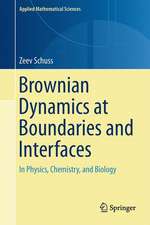Symbolic Dynamics: One-sided, Two-sided and Countable State Markov Shifts: Universitext
Autor Bruce P. Kitchensen Limba Engleză Paperback – 14 noi 1997
Din seria Universitext
- 13%
 Preț: 353.48 lei
Preț: 353.48 lei -
 Preț: 418.67 lei
Preț: 418.67 lei -
 Preț: 465.61 lei
Preț: 465.61 lei -
 Preț: 371.98 lei
Preț: 371.98 lei - 17%
 Preț: 394.41 lei
Preț: 394.41 lei -
 Preț: 356.77 lei
Preț: 356.77 lei - 17%
 Preț: 364.56 lei
Preț: 364.56 lei - 15%
 Preț: 543.75 lei
Preț: 543.75 lei - 15%
 Preț: 497.21 lei
Preț: 497.21 lei -
 Preț: 634.38 lei
Preț: 634.38 lei -
 Preț: 396.53 lei
Preț: 396.53 lei - 17%
 Preț: 427.68 lei
Preț: 427.68 lei - 13%
 Preț: 355.51 lei
Preț: 355.51 lei -
 Preț: 360.07 lei
Preț: 360.07 lei - 17%
 Preț: 365.34 lei
Preț: 365.34 lei -
 Preț: 358.44 lei
Preț: 358.44 lei - 15%
 Preț: 553.33 lei
Preț: 553.33 lei - 17%
 Preț: 364.81 lei
Preț: 364.81 lei -
 Preț: 673.45 lei
Preț: 673.45 lei - 15%
 Preț: 509.58 lei
Preț: 509.58 lei - 17%
 Preț: 427.32 lei
Preț: 427.32 lei - 17%
 Preț: 426.76 lei
Preț: 426.76 lei - 8%
 Preț: 495.43 lei
Preț: 495.43 lei - 20%
 Preț: 569.54 lei
Preț: 569.54 lei - 19%
 Preț: 429.21 lei
Preț: 429.21 lei - 17%
 Preț: 369.06 lei
Preț: 369.06 lei - 15%
 Preț: 737.46 lei
Preț: 737.46 lei - 13%
 Preț: 389.95 lei
Preț: 389.95 lei -
 Preț: 487.96 lei
Preț: 487.96 lei - 20%
 Preț: 628.22 lei
Preț: 628.22 lei -
 Preț: 372.86 lei
Preț: 372.86 lei -
 Preț: 319.07 lei
Preț: 319.07 lei -
 Preț: 379.86 lei
Preț: 379.86 lei -
 Preț: 445.88 lei
Preț: 445.88 lei -
 Preț: 382.36 lei
Preț: 382.36 lei - 15%
 Preț: 533.72 lei
Preț: 533.72 lei - 15%
 Preț: 496.02 lei
Preț: 496.02 lei - 15%
 Preț: 474.82 lei
Preț: 474.82 lei -
 Preț: 389.70 lei
Preț: 389.70 lei -
 Preț: 484.08 lei
Preț: 484.08 lei - 15%
 Preț: 469.41 lei
Preț: 469.41 lei - 15%
 Preț: 643.48 lei
Preț: 643.48 lei -
 Preț: 415.02 lei
Preț: 415.02 lei - 15%
 Preț: 602.25 lei
Preț: 602.25 lei - 20%
 Preț: 510.24 lei
Preț: 510.24 lei - 15%
 Preț: 588.37 lei
Preț: 588.37 lei -
 Preț: 381.59 lei
Preț: 381.59 lei -
 Preț: 489.87 lei
Preț: 489.87 lei -
 Preț: 493.89 lei
Preț: 493.89 lei
Preț: 583.28 lei
Preț vechi: 686.21 lei
-15% Nou
Puncte Express: 875
Preț estimativ în valută:
111.61€ • 116.84$ • 92.35£
111.61€ • 116.84$ • 92.35£
Carte tipărită la comandă
Livrare economică 05-19 aprilie
Preluare comenzi: 021 569.72.76
Specificații
ISBN-13: 9783540627388
ISBN-10: 3540627383
Pagini: 268
Ilustrații: X, 254 p. 2 illus.
Dimensiuni: 155 x 235 x 14 mm
Greutate: 0.4 kg
Ediția:Softcover reprint of the original 1st ed. 1998
Editura: Springer Berlin, Heidelberg
Colecția Springer
Seria Universitext
Locul publicării:Berlin, Heidelberg, Germany
ISBN-10: 3540627383
Pagini: 268
Ilustrații: X, 254 p. 2 illus.
Dimensiuni: 155 x 235 x 14 mm
Greutate: 0.4 kg
Ediția:Softcover reprint of the original 1st ed. 1998
Editura: Springer Berlin, Heidelberg
Colecția Springer
Seria Universitext
Locul publicării:Berlin, Heidelberg, Germany
Public țintă
ResearchCuprins
1. Background and Basics.- § 1.1 Subshifts of Finite Type.- § 1.2 Examples.- § 1.3 Perron-Frobenius Theory.- § 1.4 Basic Dynamics.- Notes.- References.- 2. Topology Conjugacy.- § 2.1 Decomposition of Topological Conjugacies.- § 2.2 Algebraic Consequences of Topological Conjugacy.- Notes.- References.- 3. Automorphisms.- § 3.1 Automorphisms.- § 3.2 Automorphisms as Conjugacies.- § 3.3 Subgroups of the Automorphism Group.- § 3.4 Actions of Automorphisms.- § 3.5 Summary.- Notes.- References.- 4. Embeddinggs and Factor Maps.- § 4.1 Factor Maps.- § 4.2 Finite-to-one Factor Maps.- §4.3 Special Constructions Involving Factor Maps.- § 4.4 Subsystems and Infinite-to-One Factor Maps.- Notes.- References.- 5. Almost-Topological Conjugacy.- § 5.1 Reducible Subshifts of Finite Type.- § 5.2 Almost-Topological Conjugacy.- Notes.- References.- 6. Further Topics.- § 6.1 Sofic Systems.- § 6.2 Markov Measures and the Maximal Measure.- § 6.3 Markov Subgroups.- § 6.4 Cellular Automata.- § 6.5 Channnel Codes.- Notes.- References.- 7. Countable State Markov Shifts.- § 7.1 Perron-Frobenius Theory.- § 7.2 Basic Symbolic Dynamics.- Notes.- References.- Name Index.
Recenzii
"...a clear and efficient treatment of an intrinsically interesting subject and would be a valuable addition to any dynamicists mathematical library." - UK Nonlinear News
Textul de pe ultima copertă
This is a thorough introduction to the dynamics of one-sided and two-sided Markov shifts on a finite alphabet and to the basic properties of Markov shifts on a countable alphabet. These are the symbolic dynamical systems defined by a finite transition rule. The basic properties of these systems are established using elementary methods. The connections to other types of dynamical systems, cellular automata and information theory are illustrated with numerous examples. The book is written for graduate students and others who use symbolic dynamics as a tool to study more general systems.
Caracteristici
An accessible book (for students) on a hot topic in mathematics












